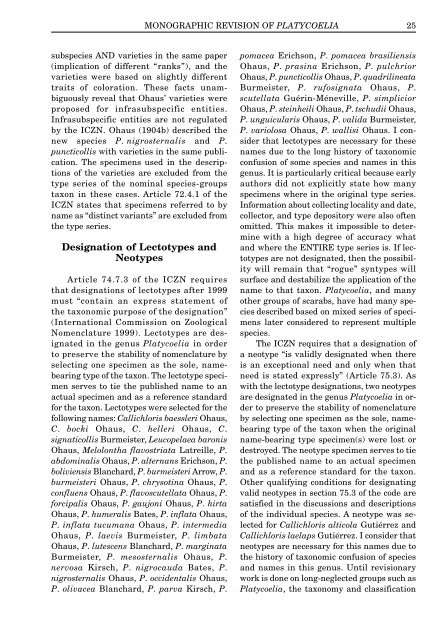Download full text (PDF 4.5 MB) - University of Nebraska State ...
Download full text (PDF 4.5 MB) - University of Nebraska State ...
Download full text (PDF 4.5 MB) - University of Nebraska State ...
Create successful ePaper yourself
Turn your PDF publications into a flip-book with our unique Google optimized e-Paper software.
subspecies AND varieties in the same paper<br />
(implication <strong>of</strong> different “ranks”), and the<br />
varieties were based on slightly different<br />
traits <strong>of</strong> coloration. These facts unambiguously<br />
reveal that Ohaus’ varieties were<br />
proposed for infrasubspecific entities.<br />
Infrasubspecific entities are not regulated<br />
by the ICZN. Ohaus (1904b) described the<br />
new species P. nigrosternalis and P.<br />
puncticollis with varieties in the same publication.<br />
The specimens used in the descriptions<br />
<strong>of</strong> the varieties are excluded from the<br />
type series <strong>of</strong> the nominal species-groups<br />
taxon in these cases. Article 72.4.1 <strong>of</strong> the<br />
ICZN states that specimens referred to by<br />
name as “distinct variants” are excluded from<br />
the type series.<br />
Designation <strong>of</strong> Lectotypes and<br />
Neotypes<br />
Article 74.7.3 <strong>of</strong> the ICZN requires<br />
that designations <strong>of</strong> lectotypes after 1999<br />
must “contain an express statement <strong>of</strong><br />
the taxonomic purpose <strong>of</strong> the designation”<br />
(International Commission on Zoological<br />
Nomenclature 1999). Lectotypes are designated<br />
in the genus Platycoelia in order<br />
to preserve the stability <strong>of</strong> nomenclature by<br />
selecting one specimen as the sole, namebearing<br />
type <strong>of</strong> the taxon. The lectotype specimen<br />
serves to tie the published name to an<br />
actual specimen and as a reference standard<br />
for the taxon. Lectotypes were selected for the<br />
following names: Callichloris baessleri Ohaus,<br />
C. bocki Ohaus, C. helleri Ohaus, C.<br />
signaticollis Burmeister, Leucopelaea baronis<br />
Ohaus, Melolontha flavostriata Latreille, P.<br />
abdominalis Ohaus, P. alternans Erichson, P.<br />
boliviensis Blanchard, P. burmeisteri Arrow, P.<br />
burmeisteri Ohaus, P. chrysotina Ohaus, P.<br />
confluens Ohaus, P. flavoscutellata Ohaus, P.<br />
forcipalis Ohaus, P. gaujoni Ohaus, P. hirta<br />
Ohaus, P. humeralis Bates, P. inflata Ohaus,<br />
P. inflata tucumana Ohaus, P. intermedia<br />
Ohaus, P. laevis Burmeister, P. limbata<br />
Ohaus, P. lutescens Blanchard, P. marginata<br />
Burmeister, P. mesosternalis Ohaus, P.<br />
nervosa Kirsch, P. nigrocauda Bates, P.<br />
nigrosternalis Ohaus, P. occidentalis Ohaus,<br />
P. olivacea Blanchard, P. parva Kirsch, P.<br />
MONOGRAPHIC REVISION OF PLATYCOELIA 25<br />
pomacea Erichson, P. pomacea brasiliensis<br />
Ohaus, P. prasina Erichson, P. pulchrior<br />
Ohaus, P. puncticollis Ohaus, P. quadrilineata<br />
Burmeister, P. rufosignata Ohaus, P.<br />
scutellata Guérin-Méneville, P. simplicior<br />
Ohaus, P. steinheili Ohaus, P. tschudii Ohaus,<br />
P. unguicularis Ohaus, P. valida Burmeister,<br />
P. variolosa Ohaus, P. wallisi Ohaus. I consider<br />
that lectotypes are necessary for these<br />
names due to the long history <strong>of</strong> taxonomic<br />
confusion <strong>of</strong> some species and names in this<br />
genus. It is particularly critical because early<br />
authors did not explicitly state how many<br />
specimens where in the original type series.<br />
Information about collecting locality and date,<br />
collector, and type depository were also <strong>of</strong>ten<br />
omitted. This makes it impossible to determine<br />
with a high degree <strong>of</strong> accuracy what<br />
and where the ENTIRE type series is. If lectotypes<br />
are not designated, then the possibility<br />
will remain that “rogue” syntypes will<br />
surface and destabilize the application <strong>of</strong> the<br />
name to that taxon. Platycoelia, and many<br />
other groups <strong>of</strong> scarabs, have had many species<br />
described based on mixed series <strong>of</strong> specimens<br />
later considered to represent multiple<br />
species.<br />
The ICZN requires that a designation <strong>of</strong><br />
a neotype “is validly designated when there<br />
is an exceptional need and only when that<br />
need is stated expressly” (Article 75.3). As<br />
with the lectotype designations, two neotypes<br />
are designated in the genus Platycoelia in order<br />
to preserve the stability <strong>of</strong> nomenclature<br />
by selecting one specimen as the sole, namebearing<br />
type <strong>of</strong> the taxon when the original<br />
name-bearing type specimen(s) were lost or<br />
destroyed. The neotype specimen serves to tie<br />
the published name to an actual specimen<br />
and as a reference standard for the taxon.<br />
Other qualifying conditions for designating<br />
valid neotypes in section 75.3 <strong>of</strong> the code are<br />
satisfied in the discussions and descriptions<br />
<strong>of</strong> the individual species. A neotype was selected<br />
for Callichloris alticola Gutiérrez and<br />
Callichloris laelaps Gutiérrez. I consider that<br />
neotypes are necessary for this names due to<br />
the history <strong>of</strong> taxonomic confusion <strong>of</strong> species<br />
and names in this genus. Until revisionary<br />
work is done on long-neglected groups such as<br />
Platycoelia, the taxonomy and classification
















